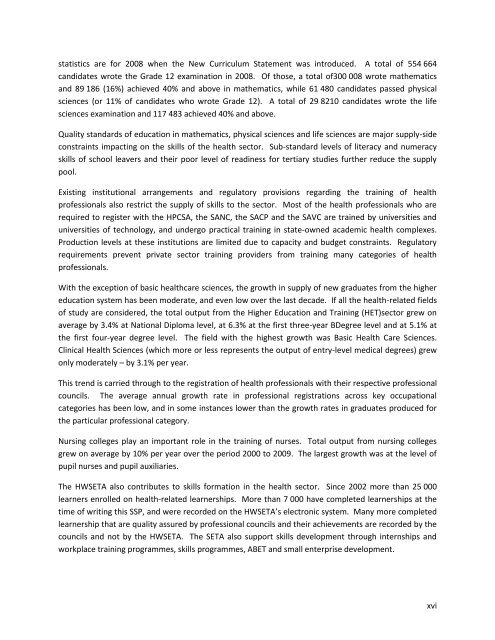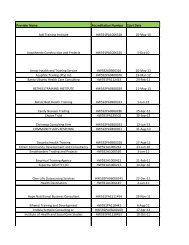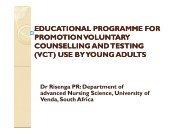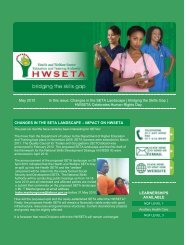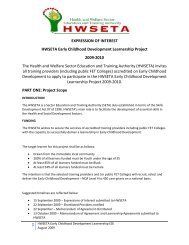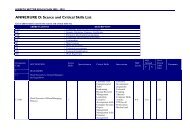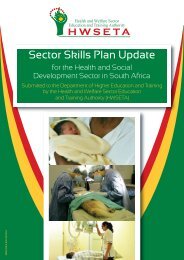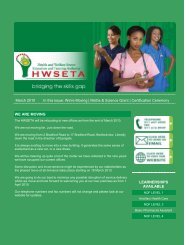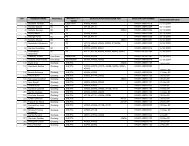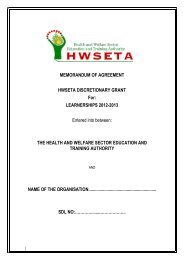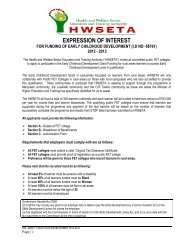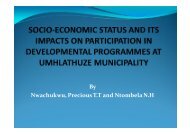sector skills plan for the health sector in south africa
sector skills plan for the health sector in south africa
sector skills plan for the health sector in south africa
You also want an ePaper? Increase the reach of your titles
YUMPU automatically turns print PDFs into web optimized ePapers that Google loves.
statistics are <strong>for</strong> 2008 when <strong>the</strong> New Curriculum Statement was <strong>in</strong>troduced. A total of 554 664<br />
candidates wrote <strong>the</strong> Grade 12 exam<strong>in</strong>ation <strong>in</strong> 2008. Of those, a total of300 008 wrote ma<strong>the</strong>matics<br />
and 89 186 (16%) achieved 40% and above <strong>in</strong> ma<strong>the</strong>matics, while 61 480 candidates passed physical<br />
sciences (or 11% of candidates who wrote Grade 12). A total of 29 8210 candidates wrote <strong>the</strong> life<br />
sciences exam<strong>in</strong>ation and 117 483 achieved 40% and above.<br />
Quality standards of education <strong>in</strong> ma<strong>the</strong>matics, physical sciences and life sciences are major supply-side<br />
constra<strong>in</strong>ts impact<strong>in</strong>g on <strong>the</strong> <strong>skills</strong> of <strong>the</strong> <strong>health</strong> <strong>sector</strong>. Sub-standard levels of literacy and numeracy<br />
<strong>skills</strong> of school leavers and <strong>the</strong>ir poor level of read<strong>in</strong>ess <strong>for</strong> tertiary studies fur<strong>the</strong>r reduce <strong>the</strong> supply<br />
pool.<br />
Exist<strong>in</strong>g <strong>in</strong>stitutional arrangements and regulatory provisions regard<strong>in</strong>g <strong>the</strong> tra<strong>in</strong><strong>in</strong>g of <strong>health</strong><br />
professionals also restrict <strong>the</strong> supply of <strong>skills</strong> to <strong>the</strong> <strong>sector</strong>. Most of <strong>the</strong> <strong>health</strong> professionals who are<br />
required to register with <strong>the</strong> HPCSA, <strong>the</strong> SANC, <strong>the</strong> SACP and <strong>the</strong> SAVC are tra<strong>in</strong>ed by universities and<br />
universities of technology, and undergo practical tra<strong>in</strong><strong>in</strong>g <strong>in</strong> state-owned academic <strong>health</strong> complexes.<br />
Production levels at <strong>the</strong>se <strong>in</strong>stitutions are limited due to capacity and budget constra<strong>in</strong>ts. Regulatory<br />
requirements prevent private <strong>sector</strong> tra<strong>in</strong><strong>in</strong>g providers from tra<strong>in</strong><strong>in</strong>g many categories of <strong>health</strong><br />
professionals.<br />
With <strong>the</strong> exception of basic <strong>health</strong>care sciences, <strong>the</strong> growth <strong>in</strong> supply of new graduates from <strong>the</strong> higher<br />
education system has been moderate, and even low over <strong>the</strong> last decade. If all <strong>the</strong> <strong>health</strong>-related fields<br />
of study are considered, <strong>the</strong> total output from <strong>the</strong> Higher Education and Tra<strong>in</strong><strong>in</strong>g (HET)<strong>sector</strong> grew on<br />
average by 3.4% at National Diploma level, at 6.3% at <strong>the</strong> first three-year BDegree level and at 5.1% at<br />
<strong>the</strong> first four-year degree level. The field with <strong>the</strong> highest growth was Basic Health Care Sciences.<br />
Cl<strong>in</strong>ical Health Sciences (which more or less represents <strong>the</strong> output of entry-level medical degrees) grew<br />
only moderately – by 3.1% per year.<br />
This trend is carried through to <strong>the</strong> registration of <strong>health</strong> professionals with <strong>the</strong>ir respective professional<br />
councils. The average annual growth rate <strong>in</strong> professional registrations across key occupational<br />
categories has been low, and <strong>in</strong> some <strong>in</strong>stances lower than <strong>the</strong> growth rates <strong>in</strong> graduates produced <strong>for</strong><br />
<strong>the</strong> particular professional category.<br />
Nurs<strong>in</strong>g colleges play an important role <strong>in</strong> <strong>the</strong> tra<strong>in</strong><strong>in</strong>g of nurses. Total output from nurs<strong>in</strong>g colleges<br />
grew on average by 10% per year over <strong>the</strong> period 2000 to 2009. The largest growth was at <strong>the</strong> level of<br />
pupil nurses and pupil auxiliaries.<br />
The HWSETA also contributes to <strong>skills</strong> <strong>for</strong>mation <strong>in</strong> <strong>the</strong> <strong>health</strong> <strong>sector</strong>. S<strong>in</strong>ce 2002 more than 25 000<br />
learners enrolled on <strong>health</strong>-related learnerships. More than 7 000 have completed learnerships at <strong>the</strong><br />
time of writ<strong>in</strong>g this SSP, and were recorded on <strong>the</strong> HWSETA’s electronic system. Many more completed<br />
learnership that are quality assured by professional councils and <strong>the</strong>ir achievements are recorded by <strong>the</strong><br />
councils and not by <strong>the</strong> HWSETA. The SETA also support <strong>skills</strong> development through <strong>in</strong>ternships and<br />
workplace tra<strong>in</strong><strong>in</strong>g programmes, <strong>skills</strong> programmes, ABET and small enterprise development.<br />
xvi


